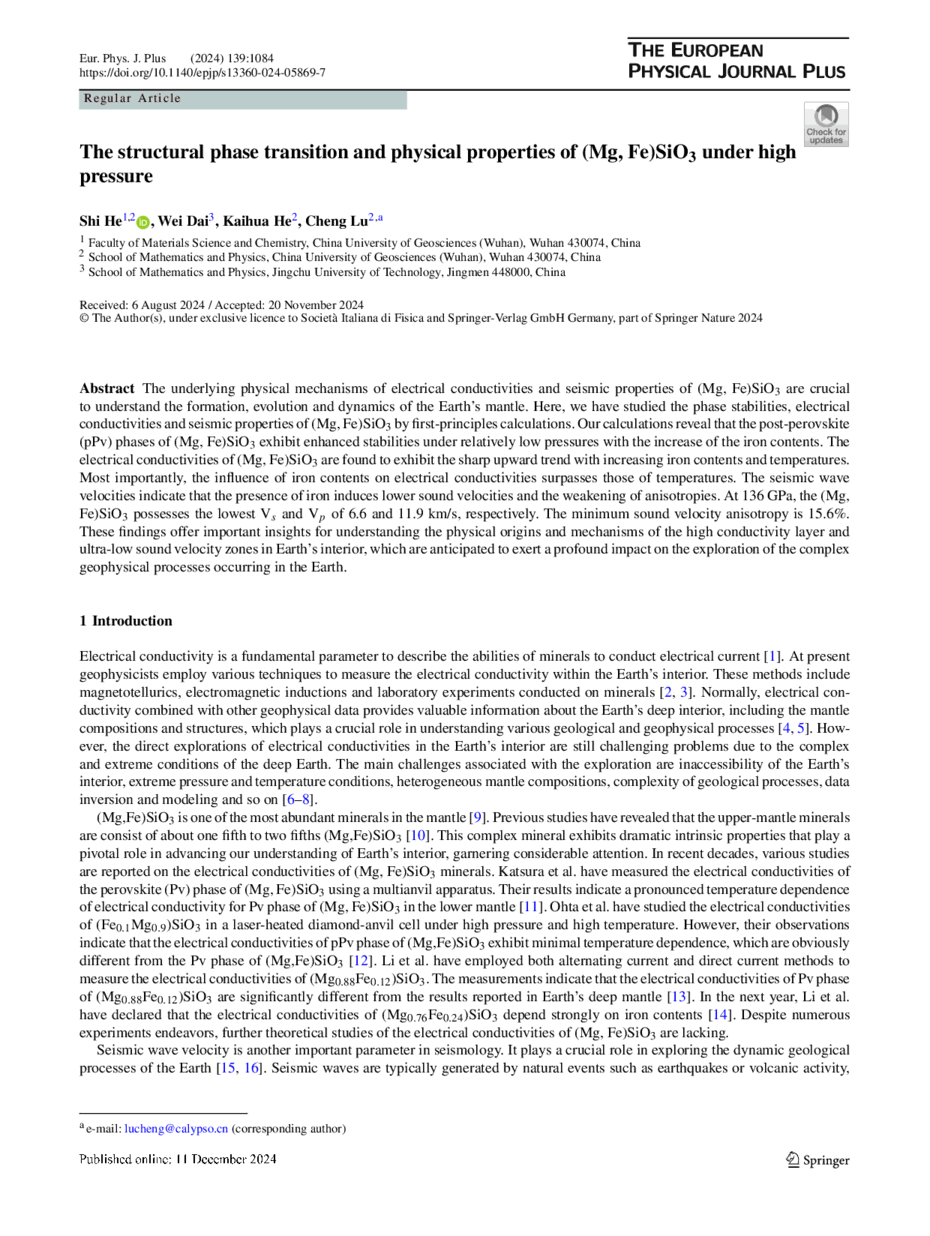https://doi.org/10.1140/epjp/s13360-024-05869-7
Regular Article
The structural phase transition and physical properties of (Mg, Fe)SiO under high pressure
under high pressure
1
Faculty of Materials Science and Chemistry, China University of Geosciences (Wuhan), 430074, Wuhan, China
2
School of Mathematics and Physics, China University of Geosciences (Wuhan), 430074, Wuhan, China
3
School of Mathematics and Physics, Jingchu University of Technology, 448000, Jingmen, China
Received:
6
August
2024
Accepted:
20
November
2024
Published online:
11
December
2024
The underlying physical mechanisms of electrical conductivities and seismic properties of (Mg, Fe) are crucial to understand the formation, evolution and dynamics of the Earth’s mantle. Here, we have studied the phase stabilities, electrical conductivities and seismic properties of (Mg, Fe)
are crucial to understand the formation, evolution and dynamics of the Earth’s mantle. Here, we have studied the phase stabilities, electrical conductivities and seismic properties of (Mg, Fe) by first-principles calculations. Our calculations reveal that the post-perovskite (pPv) phases of (Mg, Fe)
by first-principles calculations. Our calculations reveal that the post-perovskite (pPv) phases of (Mg, Fe) exhibit enhanced stabilities under relatively low pressures with the increase of the iron contents. The electrical conductivities of (Mg, Fe)
exhibit enhanced stabilities under relatively low pressures with the increase of the iron contents. The electrical conductivities of (Mg, Fe) are found to exhibit the sharp upward trend with increasing iron contents and temperatures. Most importantly, the influence of iron contents on electrical conductivities surpasses those of temperatures. The seismic wave velocities indicate that the presence of iron induces lower sound velocities and the weakening of anisotropies. At 136 GPa, the (Mg, Fe)
are found to exhibit the sharp upward trend with increasing iron contents and temperatures. Most importantly, the influence of iron contents on electrical conductivities surpasses those of temperatures. The seismic wave velocities indicate that the presence of iron induces lower sound velocities and the weakening of anisotropies. At 136 GPa, the (Mg, Fe) possesses the lowest
possesses the lowest  and
and  of 6.6 and 11.9 km/s, respectively. The minimum sound velocity anisotropy is 15.6%. These findings offer important insights for understanding the physical origins and mechanisms of the high conductivity layer and ultra-low sound velocity zones in Earth’s interior, which are anticipated to exert a profound impact on the exploration of the complex geophysical processes occurring in the Earth.
of 6.6 and 11.9 km/s, respectively. The minimum sound velocity anisotropy is 15.6%. These findings offer important insights for understanding the physical origins and mechanisms of the high conductivity layer and ultra-low sound velocity zones in Earth’s interior, which are anticipated to exert a profound impact on the exploration of the complex geophysical processes occurring in the Earth.
Supplementary Information The online version contains supplementary material available at https://doi.org/10.1140/epjp/s13360-024-05869-7.
Copyright comment Springer Nature or its licensor (e.g. a society or other partner) holds exclusive rights to this article under a publishing agreement with the author(s) or other rightsholder(s); author self-archiving of the accepted manuscript version of this article is solely governed by the terms of such publishing agreement and applicable law.
© The Author(s), under exclusive licence to Società Italiana di Fisica and Springer-Verlag GmbH Germany, part of Springer Nature 2024
Springer Nature or its licensor (e.g. a society or other partner) holds exclusive rights to this article under a publishing agreement with the author(s) or other rightsholder(s); author self-archiving of the accepted manuscript version of this article is solely governed by the terms of such publishing agreement and applicable law.





